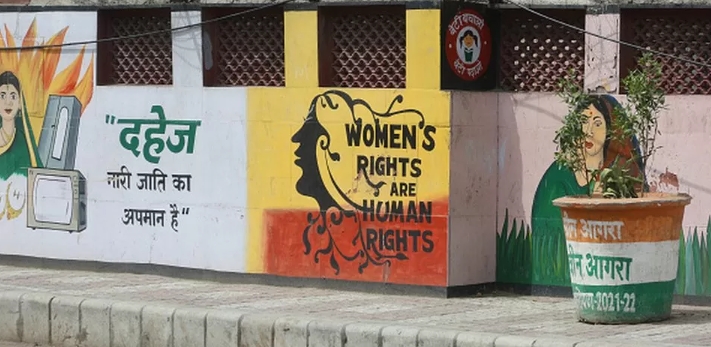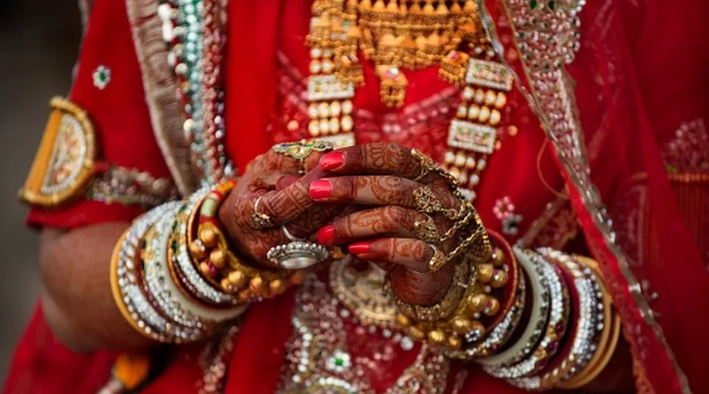A recent study reveals a correlation between the rise of education and employment opportunities for men in India and the increasing prevalence of dowry.
The exchange of dowry, a long-standing tradition in South Asia where the bride’s family presents cash, clothing, and jewelry to the groom’s family, persists in India despite being banned since 1961. This illegal practice puts women at risk of domestic violence and even death, perpetuating their vulnerability.
To analyze the evolution of dowry in India over time, researchers Jeffrey Weaver from the University of Southern California and Gaurav Chiplunkar from the University of Virginia studied over 74,000 marriages that took place between 1930 and 1999.
Using data from India’s Rural Economic and Demographic Survey, which is a panel survey covering households in 17 of the country’s most populous states, the researchers analyzed the value of cash and gifts exchanged between the bride’s family and the groom’s family. They calculated the “net dowry” by taking into account the difference between the gifts given by each family.
Until 1999, the majority of Indian marriages were arranged, and nearly all women were married by their late twenties. The study revealed that around 90% of the marriages analyzed involved dowry. The total amount of dowry payments between 1950 and 1999 reached nearly a quarter of a trillion dollars. According to Mr. Weaver, the study showed that economic growth played a significant role in perpetuating and amplifying the practice of dowry payments, particularly from the 1940s to the 1980s.
“During this period, more men were gaining education and securing better jobs, which resulted in an increase in dowry,” he explained.

Marriage in India
- The vast majority of marriages in India are monogamous.
- Less than 1% of marriages in India end in divorce.
- In over 90% of marriages between 1960 and 2005, parents were involved in selecting the spouse.
- After marriage, over 90% of couples in India live with the husband’s family.
- More than 85% of women in India marry someone from outside their own village.
- Approximately 78.3% of marriages in India are within the same district.
The study suggests that to comprehend the emergence and evolution of dowry, it is crucial to examine the shifting distribution of groom quality, which is closely tied to improvements in their education and income. The disproportionate representation of women in India’s workforce has resulted in a greater availability of higher-quality jobs for men, thereby influencing the dynamics of dowry.
Put simply, the study reveals that grooms with higher education and better job prospects are associated with higher dowries. However, as the number of educated grooms in the marriage market rises, the “dowry premium” that highly educated grooms receive diminishes, indicating a decrease in the disparity of dowry amounts among different educational backgrounds.
According to Mr. Weaver and Mr. Chiplunkar, dowry is sustained by significant economic factors. Families who do not pay dowry for their daughters often end up with grooms of lower socioeconomic status. On the other hand, grooms have a compelling economic motive to accept dowry, especially when their own family has to pay dowry for their female members or when they aim to recover the investments made in the groom’s education.
Does this phenomenon exist exclusively in India?
A different research paper by Siwan Anderson from the University of British Columbia suggests that, unlike India, dowry payments decreased as wealth increased in various societies, including Europe. Anderson argues that in caste-based societies like India, an increase in wealth actually leads to higher dowry payments. In contrast, Mr. Weaver and Mr. Chiplunkar argue that their research provides little evidence supporting the conventional explanations for the rise of dowry practices.

A prevailing theory suggests that dowry originated among upper caste households and subsequently spread as lower castes imitated these practices in an effort to enhance their social status. However, the new study challenges this notion by highlighting that the practice of dowry emerged at a similar time for both high and low caste groups, making it unclear if caste-based emulation is the primary factor driving its adoption.
Furthermore, there is a belief among some experts that the aspiration of lower caste women to marry higher caste men influenced the dynamics of dowry. However, Mr Weaver dismisses this perspective, emphasizing the scarcity of inter-caste marriages. According to the study, 94% of the analyzed marriages involved Hindus who married within their broader caste category, suggesting that the hypothesis of cross-caste marriage as a driving force behind dowry changes is incorrect.
The increase in women’s education in recent decades in India has raised questions about the impact on dowry practices. While it is plausible that the rise in women’s education could contribute to a decline in dowry, Mr Weaver notes that there is currently no data to support this claim. However, the study did uncover evidence suggesting that as the number of educated women in a particular area increased, the size of dowry payments tended to decrease. This finding indicates a potential correlation between women’s education and dowry practices, although further research is needed to establish a causal relationship.
The study found that while increasing the average duration of female education by one year had a smaller impact on dowry compared to increasing the average duration of male education by the same amount, the reasons behind this discrepancy are likely due to women’s lower workforce participation and limited economic returns from their education. These findings emphasize the importance of promoting women’s education and enhancing their involvement in the workforce as crucial steps in addressing the issue of dowry. By empowering women economically and providing them with more opportunities, society can work towards mitigating the prevalence of dowry practices.




